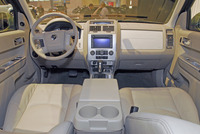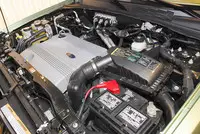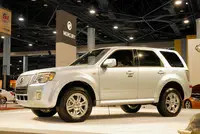2008 Mercury Mariner Preview
 Just about everything inside the Mariner has been upgraded. The glass is thicker, carpets plusher, and seats fancier. Note the new center stack and the digital readout at the very top. |
 Major improvements were made to the electronic brain that controls the Mariner Hybrid. Smoother transitions between conventional and electric power sources was the goal |
SEE ALSO: Mercury Buyers Guide
Ahoy mates, a new Mariner is ready to cast off.
Mercury refreshes its entry-level SUV for 2008.By Rex Roy
The Auto Channel
Little SUVs are big business. Some of the best-selling vehicles in the land are compact SUVs with names like CR-V, RAV4, and Equinox. These nameplates routinely hit yearly sales marks that are well into six figures. Comparatively, the Mercury Mariner is a sales chart back marker only sells 17-percent as many units as its very popular sibling, the Ford Escape (with over 168,000 produced through October, 2006). Those in charge at Mercury would like to improve the Mariner's sales performance, and in quest of this goal have refreshed their entry-level SUV in some significant ways—many of which you can't see.
Our first glimpse of the 2008 Mariner was at the Miami auto show. Here's what we saw, starting with the obvious: changes you can see include the new sheet metal up front. The new hood has what designers call a bigger "forehead," referring to the surface at the hood's leading edge. The hood's new profile is more squared-off and elegant. Mercury stylists also redesigned the headlamps to have a more technically sophisticated look, and crafted a fascia to hold the new look together. To keep things balanced, the rear fascia and taillamps were revised as well. Other less noticeable changes were made that cleaned up the Mariner's look by banishing lower bodyside cladding and incrementally reduced its aerodynamic drag by cleaning up trim.
Changes you can't see are truly transparent. One is the thicker windshield with an added noise-absorbing laminate. The second are the thicker side windows, also upgraded for noise abatement. Refinement is what Mercury is chasing with changes like these. To reduce sound levels even further, the doors have more sound insulation, the carpeting is thicker, and the headliner has an added acoustic barrier.
Refinement is also why designers updated the Mariner's interior with new seats, door panels, and a completely new center stack. The new design puts the main display up near eye level, helping drivers keep their eyes higher and closer to the road. Digital readouts for the audio and climate control systems display up top.
Lighting for the entire gauge set is now blue – it's slick looking and a true boon for those with color blindness (approximately 1 out of 100 males) that makes reading red LED all but impossible. The center console is also new, and yawns widely enough to swallow a laptop. Interior bits finished in satin pewter and chrome complete the interior's update. The new interior looks good and certainly freshens things up.
The Mariner's conventional powertrains (a 2.3-liter 4-cylinder and a 3.0-liter V6) were left unchanged, but the hybrid received attention. Significant refinements were made to the controller that coordinates the complex interplay of this full hybrid's 4-cylinder Atkinson cycle engine, 70 kW electric motor, and continuously variable automatic transmission. The results include better integration and smoother transitions between power sources themselves, and between the powertrain with the regenerative braking system. Further improving efficiency, the rack-and-pinion steering system is now powered electrically, instead of using a conventional hydraulic pump.
According to Ford Motor Company engineers, these changes significantly improve the 2008 Mariner compared to the one it supersedes (introduced in 2005). Certainly, the new styling further differentiates the Mariner from the Ford Escape. As proof of their efforts regarding NVH, engineers cited that in tests measuring interior noise, sound levels dropped an impressive 12 percent (from 30.8 sones to 27 sones at 80 mph in the wind tunnel). As soon as we can arrange a drive, we'll let you know what our ears hear.
It's no secret that for Mercury to survive, it needs to build vehicles that people want. Mercury's brand manager, Kim Irwin told the press, "The 2008 Mariner is the first product to truly deliver 100 percent of the design DNA for Mercury as a brand." To the optimist, the new Mariner looks to be a step in the right direction. To the pessimist, the Mariner is what a cash-strapped team could do with a rebadged compact SUV introduced in 2001. Regardless of your take on the situation, the realist asks, "Is it enough?"



